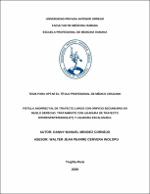Mostrar el registro sencillo del ítem
Fistula anorrectal de trayecto largo con orificio secundario en muslo derecho. Tratamiento con ligadura de trayecto interesfinteriano (LIFT) y ligadura escalonada
| dc.contributor.advisor | Cervera Inolopu, Walter Jean Pearre | |
| dc.contributor.author | Méndez Cornejo, Danny Manuel | |
| dc.creator | Méndez Cornejo, Danny Manuel | |
| dc.date.accessioned | 2020-10-29T18:59:27Z | |
| dc.date.available | 2020-10-29T18:59:27Z | |
| dc.date.issued | 2020 | |
| dc.identifier.uri | https://hdl.handle.net/20.500.12759/6696 | |
| dc.description.abstract | Presentar un caso de fistula anorrectal (FAR) de trayecto largo con ligadura de trayecto interesfinteriano (LIFT) y ligadura escalonada. Materiales y Métodos: Se presenta el caso de un paciente de sexo masculino de 43 años, sin ningún antecedente médicos de importancia. Presento anteriormente 2 abscesos, que fueron resueltos. Después de un periodo de 3 años presento enrojecimiento en la región posterior del muslo derecho, que con una fistulografía se confirma una fistula de trayecto largo. Resultados: En el intraoperatorio se evidencia la fistula anorrectal. Por lo que se realiza el principio terapéutico de Rojanasakul de obliterar el orificio primario, realizar una ligadura interesfintérina (LIFT) con ligadura escalonada. La cirugía concluyó con cierre de las incisiones exploratorias con puntos invertidos. No sé ha evidenciado recurrencias ni complicaciones en 15 meses de seguimiento. Discusión: El abordaje de ligadura interesfinteriana (LIFT) y ligadura escalonada debe de ser considerado como un manejo alternativo en la presentación de una fistula compleja con este tipo de trayecto. Conclusión: Este reporte se suma a la evidencia actual en cuanto al abordaje evitando recurrencia e incontinencia fecal. | es_PE |
| dc.description.abstract | To present a case of a long path anorectal fistula (FAR) with intersphincteric path ligation (LIFT) and step ligation. Materials and Methods: The case of a 43-year-old male patient is presented, without any important medical history. previously presenting 2 abscesses, which were resolved. After a period of 3 years, I present redness in the posterior region of the right thigh, which with a fistulography confirms a long-distance fistula. Results: Intraoperatively, anorectal fistula is evident, close to the muscle and vascular vessels. Therefore, the Rojanasakul therapeutic principle of obliterating the primary orifice, performing an intersphincterine ligation (LIFT) with extrasphincteric fistulectomy is carried out. The surgery concluded with the closure of the exploratory incisions with inverted stitches. He is asymptomatic in 15 months of follow-up. Discussion: The intersphincteric ligation approach (LIFT) and step ligation should be considered as a management of choice due to the presentation of a complex fistula in its course. Conclusion: This report adds to the current evidence regarding the approach to avoid recurrence and fecal incontinence | en_US |
| dc.description.uri | Tesis | es_PE |
| dc.format | application/pdf | es_PE |
| dc.language.iso | spa | es_PE |
| dc.publisher | Universidad Privada Antenor Orrego | es_PE |
| dc.relation.ispartofseries | T_MED_2856 | |
| dc.rights | info:eu-repo/semantics/openAccess | es_PE |
| dc.source | Universidad Privada Antenor Orrego | es_PE |
| dc.source | Repositorio institucional - UPAO | es_PE |
| dc.subject | Fistula Anal | es_PE |
| dc.subject | Ligadura Interesfinteriana | es_PE |
| dc.title | Fistula anorrectal de trayecto largo con orificio secundario en muslo derecho. Tratamiento con ligadura de trayecto interesfinteriano (LIFT) y ligadura escalonada | es_PE |
| dc.type | info:eu-repo/semantics/bachelorThesis | es_PE |
| thesis.degree.level | Título Profesional | es_PE |
| thesis.degree.grantor | Universidad Privada Antenor Orrego. Facultad de Medicina Humana | es_PE |
| thesis.degree.name | Médico Cirujano | es_PE |
| thesis.degree.discipline | Medicina | es_PE |
Ficheros en el ítem
Este ítem aparece en la(s) siguiente(s) colección(es)
-
Medicina Humana [2739]

